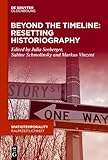Beyond the Timeline: Resetting Historiography / ed. by Julia Seeberger, Sabine Schmolinsky, Markus Vinzent.
Material type: TextSeries: SpatioTemporality / RaumZeitlichkeit : Practices-Concepts-Media / Praktiken - Konzepte - Medien ; 16Publisher: Mnchen ; Wien : De Gruyter Oldenbourg, [2024]Copyright date: 2024Description: 1 online resource (VI, 290 p.)Content type:
TextSeries: SpatioTemporality / RaumZeitlichkeit : Practices-Concepts-Media / Praktiken - Konzepte - Medien ; 16Publisher: Mnchen ; Wien : De Gruyter Oldenbourg, [2024]Copyright date: 2024Description: 1 online resource (VI, 290 p.)Content type: - 9783111154749
- 9783111160023
- 9783111157610
- 907.2 23//eng/20241011eng
- online - DeGruyter
- Issued also in print.
| Item type | Current library | Call number | URL | Status | Notes | Barcode | |
|---|---|---|---|---|---|---|---|
 eBook
eBook
|
Biblioteca "Angelicum" Pont. Univ. S.Tommaso d'Aquino Nuvola online | online - DeGruyter (Browse shelf(Opens below)) | Online access | Not for loan (Accesso limitato) | Accesso per gli utenti autorizzati / Access for authorized users | (dgr)9783111157610 |
Frontmatter -- Inhalt -- Gibt es Rezepte, wie wir Geschichtsschreibung auf den Kopf stellen können? Ein Gespräch -- Geschichtsschreibung jenseits des Zeitstrahls? -- Two Bricks of History Turned Upside Down – Facts and Evidence -- I: Modes of Narrating (Her/Hi)story -- Anomalien der Zeitlichkeit -- Reisen in die Geschichte. Eine Topologie -- Tell me, show me, play with me? Reflections on forms of narrating and reading history -- II: Turns in Medieval Historiography -- Chronomorphosen. Unhistorische Zeitverläufe in mittelalterlicher Historiographie (am Beispiel der ‚Kaiserchronik‘) -- Mehr Historiographiegeschichte – ein Plädoyer. Terminologie und Rezeption als Kernthemen einer anachronen Geschichtsschreibung -- Marguerite Poretes Tugendverständnis und ihre Verurteilung als libertinistische Ketzerin in retrospektiver Sicht -- Ein anderes Gesicht von Eckhart -- III: Spatio-Temporal Approaches -- Historiographien unmöglicher Zukünfte. Wie Simone Weil Geschichtsspüren erschreibt -- Genozid und antichronologisches Erzählen. Zum Konzept der „extremen Grundlosigkeit“ in autobiographischen Texten überlebender Tutsi und Juden -- Brazil Moving Backwards: Same Crisis, Different Scales -- Rhapsodic narrative in stories told with sounds (on the example of ballads and rhapsodies) -- About the Authors
restricted access online access with authorization star
http://purl.org/coar/access_right/c_16ec
Different from literary works (prose, drama etc.) with techniques like montage and contemporary media (film, documentaries, video games, internet) where time-lines are being questioned through flashbacks and flashwords, historiography seems to have resisted such challenges. Most historiographical works (biographies, scholarly studies) still adhere to chronological narratives, even though the boundaries between history and literary fiction have been blurred over the past decades. Responding to 20th/21st c. attempts like Walter Benjamin’s prophetic historian, this volume asks: How to write history without following the chronologically oriented trajectory of time? The interdisciplinary contributions from a broad range of history (medieval, modern, music, sciences), sociology, life sciences, genocide research go back to a symposium that responded to a publication of Markus Vinzent (Writing the History of Early Christianity. From Reception to Retrospection of 2019, Cambridge University Press). The scholars engage with the idea of retrospection as a method of critical historiography. Writing retrospectively is not simply a matter of presentism, reversing chronology, it disrupts continuities and teleologies and opens creative futures.
Issued also in print.
Mode of access: Internet via World Wide Web.
In English.
Description based on online resource; title from PDF title page (publisher's Web site, viewed 20. Nov 2024)


